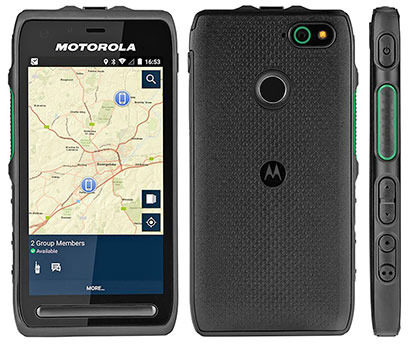On March 7, 2018, Motorola Solutions introduced the LEX L11, which the company calls a "Mission-Critical LTE Device." We'd call it a rugged Android smartphone/handheld computer supporting global broadband networks including FirstNet in the US, and designed specifically for first responders so they can access secure apps for increased situational awareness. So what exactly is the LEX L11?

Motorola Solutions calls it a mission-critical handheld or LTE device (we prefer the former). The LEX L11 has pretty much the exact same footprint of an Apple iPhone 8 Plus, but it's really an entirely different type of device, one that connects to public safety LTE broadband, is remarkably rugged, and was designed from the ground up to give public safety personnel a tool they can count on in the thick of things.
The emphasis here is on providing critical information in the field, helping with monitoring the environment, gathering information, and just generally be more aware. Which requires hardware, software and security that transcends what's available in consumer phones.
Considering these ambitious goals, the LEX L11 is remarkably small, light, and handy. It measures just 6.0 x 3.07 x .52 inches and weighs just over nine ounces with the standard battery. Due to its durable construction the LEX is almost twice as thick as the super-slender iPhone but really doesn't weigh that much more, just a couple of ounces.
The LEX L11 has a 5.0-inch display with 720 x 1280 WVGA resolution, a bit larger than the 4.7-inch screen of the predecessor LEX 10 (and that accounts for the slightly larger footprint as well). And like virtually all consumer smartphones, the LEX L11 has a capacitive multi-touch screen.

When Motorola Solutions started with the LEX line of handhelds in 2012, the original LEX 700 still ran Windows Embedded Handheld 6.5.3. In 2015, the much improved LEX L10 was Android-only from the start, as is the new LEX 11 that comes with Android "Nougat" 7.1.
Oddly, the specs contain no information on the processor, but it was brought to our attention that it's an octa-core Qualcomm SDM660. There are 4GB of RAM and 64GB of mass storage, and that's expandable by up to 128GB via microSD card. There's a modern USB-C port, a standard 3.5mm audio jack, and an accessory/charging surface mount port.
The auto-focus camera has smartphone-class 13 megapixel resolution and an LED flash, and even the documentation camera sports an impressive 8 megapixel imager. There are triple microphones for superior voice quality, and the dual 1-watt speakers can generate loudness up to 106 dB!
On the wireless and communications side the LEX L11 shines as well. Since public safety agencies heavily rely on voice communications, the LEX L11 was not only designed for one-handed operation, it also has a dedicated, tactile push-to-talk (PTT) button. It supports a multitude of 4G LTE, depending on region, but can also connect to other networks, including carrier 3G/UMTS and Quad Band GSM.
The LEX L11 can also be paired with an APX two-way portable radio, combining Motorola Solutions' mission-critical ASTRO 25 LMR network with public safety broadband. That's a plus for officers who need to remain discreet while communicating covertly on their radio as they use the LEX L11.
On the ruggedness side of things, sealing is at the IP67 level, where the "6" means the device is fully dustproof, and the "7" means it's also fully waterproof, including immersion down to about three feet. The LEX L11 can handle 4-foot drops, and the -4° to 131° Fahrenheit operating temperature range is wide enough for deployment almost anywhere. The display is damage-protected via Gorilla Glass 3. Moto doesn't spec what the LEX L11 is made of, but it looks rather tough and well-protected.



